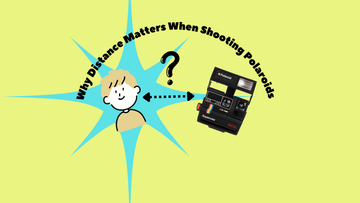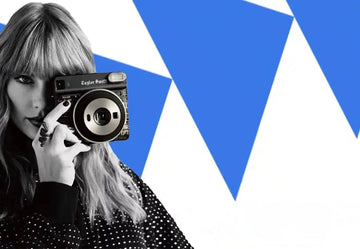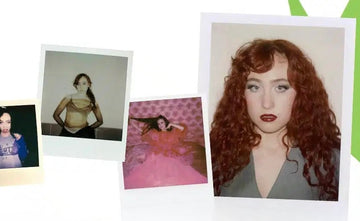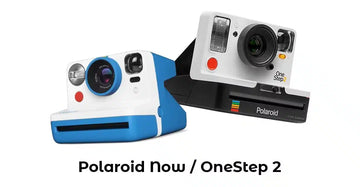Get Closer! Why Distance Matters When Shooting Polaroids
bis Дашка Шипунова auf Jul 29, 2025

The Power of Proximity in Polaroid Photography
As a passionate Polaroid photographer, I've learned that one of the most important factors in capturing stunning instant shots is getting up close and personal with your subject. The distance between your camera and your focal point can make or break a Polaroid photo, and understanding how to leverage this principle is key to unlocking the full creative potential of this unique medium.
In this in-depth blog post, we'll explore why proximity is so crucial when shooting with a Polaroid camera, and I'll share my top tips and techniques for framing your subjects to achieve the best possible results. Whether you're a seasoned Polaroid pro or just starting to experiment with this captivating format, you're sure to walk away with a deeper understanding of how to master the art of the close-up Polaroid shot.
The Polaroid Difference: Why Proximity Matters
One of the defining characteristics of Polaroid photography is the intimate, almost tactile quality of the images. Unlike digital photography, where you can easily zoom in and out to frame your subject, Polaroid cameras have a fixed lens that requires you to physically move closer to your subject in order to fill the frame.
This proximity-based approach to framing has a number of important implications:
- Emphasis on the Subject: By getting up close, you're able to make your subject the undisputed star of the frame, minimizing distracting background elements and ensuring that the viewer's eye is immediately drawn to the most important part of the image.
- Depth and Dimension: Shooting from a closer distance creates a sense of depth and dimension in your Polaroid photos, with the subject appearing larger and more three-dimensional against the flatter background.
- Intimate Perspective: Polaroid's signature square format, combined with the close-up framing, gives your images an almost voyeuristic quality, inviting the viewer to feel like they're right there in the scene with you.
- Unique Distortion: The fixed lens of a Polaroid camera can introduce subtle distortions and aberrations, particularly when shooting from very close distances. These quirks can actually work to your advantage, adding a distinctive, analog-inspired look to your photos.
In short, getting close with your Polaroid camera isn't just a compositional choice - it's a fundamental part of the medium's unique aesthetic and creative potential. By embracing proximity, you can unlock a whole new world of expressive, evocative instant photography.
Mastering the Close-Up Polaroid Shot
Now that we've explored the importance of proximity in Polaroid photography, let's dive into some practical tips and techniques for getting the most out of your close-up shots:
1. Frame Your Subject Intentionally
When shooting with a Polaroid camera, it's crucial to be intentional about how you frame your subject within the frame. Rather than simply pointing and shooting, take a moment to carefully consider the composition and placement of your focal point.
As a general rule, you'll want to fill as much of the frame as possible with your subject, leaving minimal background elements. This helps to create a sense of intimacy and focus, drawing the viewer's eye directly to the most important part of the image.
One effective technique is to position your subject slightly off-center, using the rule of thirds to create a more dynamic and visually interesting composition. This can help to add a sense of movement and energy to your Polaroid shots.
Remember, with a Polaroid camera, you can't simply zoom in and out to adjust your framing - you'll need to physically move closer or further away from your subject. So take the time to experiment with different distances and angles until you find the perfect composition.
2. Keep the Background Simple
When shooting close-up Polaroid photos, it's important to keep the background as simple and uncluttered as possible. Busy or distracting backgrounds can quickly overwhelm the main subject, diluting the impact of your image.
One effective strategy is to look for clean, minimalist backgrounds that won't compete with your subject for attention. This could be a plain wall, a stretch of sky, or a simple, neutral-colored surface. By eliminating distractions, you can ensure that the viewer's focus remains firmly on your intended focal point.
If you're shooting in a more complex environment, try to position your subject in a way that isolates them from the background. This could involve using shallow depth of field to blur out the background, or simply finding a spot where the background elements are less prominent.
Remember, the beauty of Polaroid photography lies in its ability to capture intimate, evocative moments. By keeping the background simple, you can help to amplify the emotional impact of your close-up shots.
3. Experiment with Angle and Perspective
One of the joys of Polaroid photography is the opportunity to experiment with different angles and perspectives. When shooting close-up, this becomes even more important, as the way you position your camera can dramatically affect the final image.
Try shooting from a low angle, positioning the camera just above your subject's eye level. This can create a sense of power and importance, making your subject appear larger-than-life. Conversely, shooting from a high angle can give your subject a more vulnerable, diminished appearance.
You can also play with the orientation of your camera, shooting in both portrait and landscape modes. Each orientation will offer a unique framing and perspective, so don't be afraid to mix it up and see what works best for your subject.
Remember, the key is to approach each close-up shot with a spirit of exploration and experimentation. By trying out different angles and perspectives, you'll be able to find the most compelling and visually striking way to capture your subject.
4. Use Polaroid Film Accessories
To get the most out of your close-up Polaroid shots, it's worth investing in some specialized film accessories. One of the most useful tools is the Polaroid Close-Up Lens, which can be attached to the front of your camera to allow you to focus on subjects that are just a few inches away.
The Close-Up Lens is particularly helpful for capturing intricate details, textures, and small objects that might otherwise be difficult to frame effectively with your camera's fixed lens. By getting even closer to your subject, you can create a sense of intimacy and focus that simply can't be achieved with a standard Polaroid shot.
Another useful accessory is the Polaroid Macro Lens, which allows you to focus on subjects that are just a few centimeters away. This is perfect for capturing the tiniest of details, from the delicate petals of a flower to the intricate patterns on a butterfly's wing.
By incorporating these specialized lenses into your Polaroid workflow, you'll be able to push the boundaries of what's possible with this unique photographic medium, unlocking a whole new world of creative potential.
Putting it All Together: Polaroid Close-Up Techniques in Action
Now that we've covered the key principles and techniques for mastering close-up Polaroid photography, let's take a look at some real-world examples to see these concepts in action.
Capturing Intimate Portraits
One of the most powerful applications of close-up Polaroid photography is in the realm of portraiture. By getting up close and personal with your subject, you can create a sense of intimacy and connection that simply can't be achieved from a distance.
In this Polaroid portrait, the subject's face fills the majority of the frame, allowing us to see the intricate details of their features and expression. The simple, neutral background keeps the focus squarely on the subject, drawing the viewer's eye directly to their eyes and creating a sense of emotional resonance.
To achieve a shot like this, I positioned the camera just above the subject's eye level, using the rule of thirds to create a dynamic and visually interesting composition. I also made sure to keep the background as clean and uncluttered as possible, allowing the subject to truly shine.
By embracing the close-up approach, I was able to capture the essence of this individual in a way that feels raw, honest, and deeply personal. This is the power of Polaroid portraiture at its finest.
Highlighting Texture and Detail
Another area where close-up Polaroid photography really shines is in the realm of macro and close-up shots. By getting up close and personal with your subject, you can reveal a whole new world of intricate textures, patterns, and details that might otherwise go unnoticed.
In this Polaroid macro shot, the viewer is treated to an up-close and personal view of a delicate flower petal. The use of the Polaroid Close-Up Lens allows me to focus on the intricate veining and subtle gradations of color, creating a sense of intimacy and wonder.
To capture this image, I positioned the camera just a few inches away from the flower, carefully framing the petal to fill the majority of the frame. The simple, out-of-focus background helps to isolate the subject and draw the viewer's eye directly to the intricate details.
By embracing the close-up approach, I was able to transform a humble flower petal into a captivating and visually striking Polaroid image. This is the magic of Polaroid macro photography - the ability to reveal the hidden beauty in the smallest of things.
Telling a Story Through Proximity
Finally, close-up Polaroid photography can be a powerful tool for storytelling, allowing you to create a sense of intimacy and connection that draws the viewer into the scene.
In this Polaroid shot, the viewer is treated to a close-up view of a pair of hands carefully arranging a vintage Polaroid camera. The use of proximity not only allows us to appreciate the intricate details of the camera itself, but also creates a sense of involvement and participation in the act of photography.
To capture this image, I positioned the camera just a few inches away from the hands, using a slightly off-center composition to add a sense of dynamism and movement. The simple, neutral background keeps the focus squarely on the subject, allowing the viewer to fully immerse themselves in the moment.
By embracing the close-up approach, I was able to create a Polaroid image that feels both visually striking and emotionally resonant. This is the power of Polaroid storytelling - the ability to transport the viewer into the heart of the action and forge a deep, personal connection with the subject.
Conclusion: Embracing the Intimacy of Polaroid Photography
In conclusion, getting close with your Polaroid camera is not just a compositional choice - it's a fundamental part of unlocking the full creative potential of this unique photographic medium. By embracing proximity and leveraging the intimate, tactile qualities of Polaroid, you can create images that are raw, honest, and deeply evocative.
Whether you're capturing stunning portraits, revealing the hidden beauty of the natural world, or telling a compelling visual story, the close-up Polaroid approach can help you to forge a deeper connection with your subject and your audience. So don't be afraid to get up close and personal - the rewards of Polaroid photography await.
To learn more about mastering the art of Polaroid photography, be sure to check out our website website and our Polaroid 636 Close Up camera on Amazon. Happy shooting!




